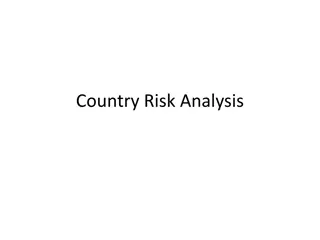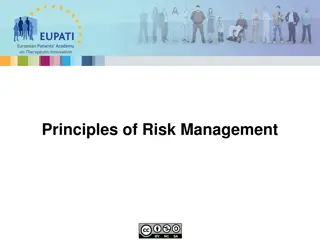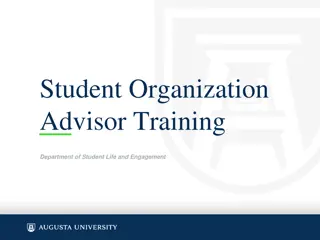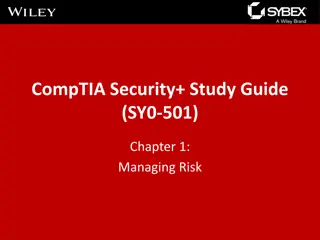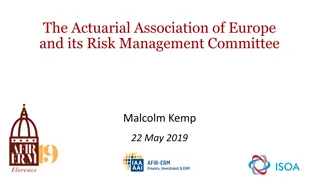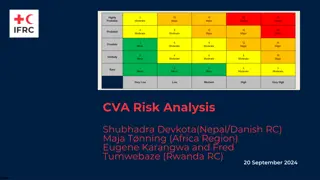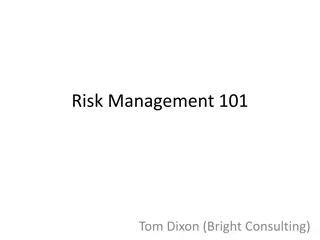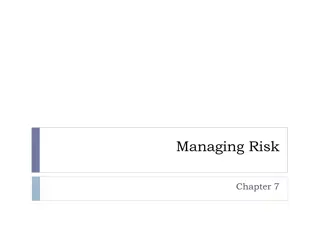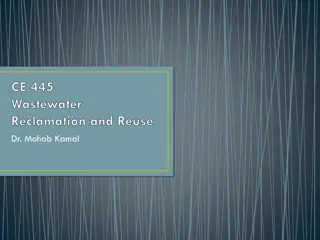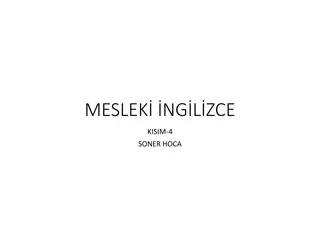Comprehensive Risk Management Guide for Student Organizations
This guide provides student organization leaders with essential training on risk management concepts, tools, and assessment. It covers the purpose of training, learning objectives, risk identification and management, high-risk activities, types of risks, risk management concepts, and the role of insurance. By following this guide, student organizations can proactively address potential risks and ensure the safety of their activities.
Download Presentation

Please find below an Image/Link to download the presentation.
The content on the website is provided AS IS for your information and personal use only. It may not be sold, licensed, or shared on other websites without obtaining consent from the author.If you encounter any issues during the download, it is possible that the publisher has removed the file from their server.
You are allowed to download the files provided on this website for personal or commercial use, subject to the condition that they are used lawfully. All files are the property of their respective owners.
The content on the website is provided AS IS for your information and personal use only. It may not be sold, licensed, or shared on other websites without obtaining consent from the author.
E N D
Presentation Transcript
Risk Management Guide for Student Organizations
Purpose of Training Provide an overview of risk management. Familiarize leaders of student organizations with risk assessment and management concepts and tools as required by Education Code 51.9361
What Will I Learn From The Training Ability to define risk management Use the risk matrix to identify and manage risk Identify risk in activities planned by an organization Develop methods to manage risk in activities planned by organization
Risk Management Concepts and Tools
What is Risk Management? Risk Management is the process of considering the potential and perceived risk involved in student activities. It includes monitoring organization activities and taking both corrective action and proactive steps to minimize accidental injury and/or loss.
High Risk Activities Alcohol and Illegal Drugs Hazing Sexual Abuse and Harassment Fire and Other Safety Issues Travel Behavior at Parties and Social Events Others?
Risk Types Physical Reputation Emotional Financial Facilities (This is used with permission from Student Risk Management at Arizona State University)
Risk Management Concepts Identify risky behavior and activities Assess the probability of adverse outcomes Identify and implement controls to eliminate or reduce the risk Reassess the activity after the risks have been managed Georgia Institute of Technology, 2002
Risk Management and Insurance Matrix
RISK MANAGEMENT AND INSURANCE MATRIX Please feel free to speak to or consult with staff in Student Activities to assist in this risk assessment and insurance management process. Step One List all event activities or concerns. Step Two Identify risks associated with each activity. Step Three Use the Matrix to determine the level of risk before applying any Risk Management strategies Step Four Brainstorm methods to manage risks. See if you can reduce the probability that something will go wrong. Step Five Submit Risk Management & Insurance Matrix with Activity Proposal to Student Activities. NAME OF EVENT: LIST SPECIAL ACTIVITIES ASSOCIATED RISKS* SERIOUSNESS PROBABILITY METHOD TO MANAGE RISKS** 1. 2. 3. 4. 1. 2. 3. 4. 1. 2. 3. 4. 1. 2. 3. 4. 1. 2. 3. 4. * Associated risks include: medical emergencies, food poisoning/allergic reactions, damage to University reputation, damage to University property and/or facilities, accidents, injury, and/or death. **Methods to manage risks may include: purchasing special event liability insurance, arranging for security through PVAMU PD, traveling with an advisor, rotating drivers, etc. SERIOUSNESS Probability B I May result in death. PROBABILITY A Likely to occur immediately or in a short period of time, expected to occur frequently. Seriousness I II III IV A C D II May cause severe injury, major property damage, significant financial loss, and/or result in negative publicity for the organization and/or institution. B Probably will come in time III May cause minor injury, illness, property damage, financial loss, and/or could result in negative publicity for the organization and/or institution. C May occur in time. D Unlikely to occur. IV Hazard presents a minimal threat to safety, health, and well-being of participants. If any special activity score is within the red or yellow the Office of Student Activities must review. The Risk Management & Insurance Matrix must be filed when an Activity Permit is submitted. The form has been provided as an educational tool to help student leaders to develop a process for identifying and discussing potential risk issues. It is intended for use as part of a larger event planning process, and should only serve as a starting point for your discussion on risk management. It is not designed to take the place of a careful review of applicable rules, policies, and laws, or discussion with your advisor. Completion of this form does not imply approval or authorization of your event by Prairie View A&M University. For more information on event planning, contact Student Activities in the Memorial Student Center, (936) 261-1340.
Sample University Sample Event Sample University Outdoors April 2008 Sample University Outdoors is a fun, free event where children are taught about wildlife, plants, and the outdoors. Events include safety in archery and shooting, plant identification, arts and crafts, fishing, fire trucks, Smokey the Bear, birds of prey display, state park information, casting lessons, and many more booths. Gates open at 9 am and close at 3pm. Children and parents are free to come any time during these hours. A free hotdog lunch is provided, along with drinks and chips.
Step One: List all risk concerns for Sample University Outdoors
PVAMU Outdoors NAME OF EVENT: LIST SPECIAL ACTIVITIES 1. BB Gun Shooting ASSOCIATED RISKS* SERIOUSNESS PROBABILITY METHOD TO MANAGE RISKS** 1. 1. 1. 1. 2. 2. 2. 2. 2. Climbing Wall 3. 3. 3. 3. 3. Archery 4. 4. 4. 4. ATV s 4. * Associated risks include: medical emergencies, food poisoning/allergic reactions, damage to University reputation, damage to University property and/or facilities, accidents, injury, and/or death. **Methods to manage risks may include: purchasing special event liability insurance, arranging for security through PVAMU PD, traveling with an advisor, rotating drivers, etc. SERIOUSNESS PROBABILITY Probability B I May result in death. A Likely to occur immediately or in a short period of time, expected to occur frequently. Seriousness I II III IV A C D II May cause severe injury, major property damage, significant financial loss, and/or result in negative publicity for the organization and/or institution. B Probably will come in time C May occur in time. III May cause minor injury, illness, property damage, financial loss, and/or could result in negative publicity for the organization and/or institution. D Unlikely to occur. IV Hazard presents a minimal threat to safety, health, and well-being of participants. If any special activity score is within the red or yellow the Office of Student Activities must review. The Risk Management & Insurance Matrix must be filed when an Activity Permit is submitted. The form has been provided as an educational tool to help student leaders to develop a process for identifying and discussing potential risk issues. It is intended for use as part of a larger event planning process, and should only serve as a starting point for your discussion on risk management. It is not designed to take the place of a careful review of applicable rules, policies, and laws, or discussion with your advisor. Completion of this form does not imply approval or authorization of your event by Prairie View A&M University. For more information on event planning, contact Student Activities in the Memorial Student Center (936) 261-1340.
Step Two: Identify risk associated with each activity Driving ATV s Other Vehicles Events BB Gun Shooting Climbing Wall Archery Physical Risks Insect Bites Slips, Trips, Falls Animal Concerns Financial Liability Insurance Reputation What If ???
Tarleton Outdoors NAME OF EVENT: LIST SPECIAL ACTIVITIES 1. BB Gun Shooting ASSOCIATED RISKS* SERIOUSNESS PROBABILITY METHOD TO MANAGE RISKS** 1. 1. 1. 1. Accident/Injury 2. 2. 2. 2. Climbing Wall 2. Accident/Injury 3. 3. 3. 3. Archery 3. Accident/Injury 4. 4. 4. 4. ATV s 4. Accident/Injury * Associated risks include: medical emergencies, food poisoning/allergic reactions, damage to University reputation, damage to University property and/or facilities, accidents, injury, and/or death. **Methods to manage risks may include: purchasing special event liability insurance, arranging for security through PVAMU PD, traveling with an advisor, rotating drivers, etc. SERIOUSNESS OF RISK PROBABILITY Probability B I May result in death. A Likely to occur immediately or in a short period of time, expected to occur frequently. Seriousness I II III IV A C D II May cause severe injury, major property damage, significant financial loss, and/or result in negative publicity for the organization and/or institution. B Probably will come in time C May occur in time. III May cause minor injury, illness, property damage, financial loss, and/or could result in negative publicity for the organization and/or institution. D Unlikely to occur. IV Hazard presents a minimal threat to safety, health, and well-being of participants. If any special activity score is within the red or yellow the Office of Student Activities must review. The Risk Management & Insurance Matrix must be filed when an Activity Proposal is require. The form has been provided as an educational tool to help student leaders to develop a process for identifying and discussing potential risk issues. It is intended for use as part of a larger event planning process, and should only serve as a starting point for your discussion on risk management. It is not designed to take the place of a careful review of applicable rules, policies, and laws, or discussion with your advisor. Completion of this form does not imply approval or authorization of your event by Prairie View A&M University. For more information on event planning, contact Student Activities in the Memorial Student Center (936) 261-1340.
Step Three: Use the matrix to determine the level of risk before applying any risk management strategies
PVAMU Outdoors ASSOCIATED RISKS* NAME OF EVENT: LIST SPECIAL ACTIVITIES 1. BB Gun Shooting SERIOUSNESS PROBABILITY METHOD TO MANAGE RISKS** 1. II 1. 1. 1. Accident/Injury 2. II 2. 2. 2. Climbing Wall 2. Accident/Injury 3. II 3. 3. 3. Archery 3. Accident/Injury 4. II 4. 4. 4. ATV s 4. Accident/Injury SERIOUSNESS I May result in death. II May cause severe injury, major property damage, significant financial loss, and/or result in negative publicity for the organization and/or institution. III May cause minor injury, illness, property damage, financial loss, and/or could result in negative publicity for the organization and/or institution. IV Hazard presents a minimal threat to safety, health, and well-being of participants.
PVAMU Outdoors ASSOCIATED RISKS* NAME OF EVENT: LIST SPECIAL ACTIVITIES 1. BB Gun Shooting SERIOUSNESS PROBABILITY METHOD TO MANAGE RISKS** 1. II 1. B 1. 1. Accident/Injury 2. II 2. 2. Climbing Wall 2. Accident/Injury 2.B 3. II 3. B 3. 3. Archery 3. Accident/Injury 4. II 4. B 4. 4. ATV s 4. Accident/Injury PROBABILITY A Likely to occur immediately or in a short period of time, expected to occur frequently. B Probably will come in time C May occur in time. D Unlikely to occur.
Tarleton Outdoors ASSOCIATED RISKS* NAME OF EVENT: LIST SPECIAL ACTIVITIES 1. BB Gun Shooting SERIOUSNESS PROBABILITY METHOD TO MANAGE RISKS** 1. II 1. B 1. 1. Accident/Injury 2. II 2. 2. Climbing Wall 2. Accident/Injury 2.B 3. II 3. B 3. 3. Archery 3. Accident/Injury 4. II 4. B 4. 4. ATV s 4. Accident/Injury Probability Seriousness A B C D I II III IV
Step Four: Brainstorm Methods to Manage Risk Find strategies you can apply to reduce the severity of the risk and probability that something will go wrong Procure Summer Camp insurance for participants providing coverage that included accident, medical and general liability. Provide medical station to treat minor issues such as insect bites, sun exposure, sprains, etc. Request ATV s to be provided by vendor in lieu of utilizing personal vehicles. Implement registration process to monitor participants. Monitor food preparation process for potential food safety concerns.
PVAMU Outdoors ASSOCIATED RISKS* NAME OF EVENT: LIST SPECIAL ACTIVITIES 1. BB Gun Shooting SERIOUSNESS PROBABILITY METHOD TO MANAGE RISKS** 1. II 1. B 1. Proper one on one Instruction/Supervision 2. One on one Instruction/Participation Vendor certified supervision 3. One on One Instruction/Supervision 1. Accident/Injury 2. II 1.B 2. Climbing Wall 2. Accident/Injury 3. II 3. B 3. Archery 3. Accident/Injury 4. II 4. B 4. Restricting use to Advisor/Organization not participants. Provide orientation for use limitations and routes. Use vendor ATV s instead of personal units. 4. ATV s 4. Accident/Injury * Associated risks include: medical emergencies, food poisoning/allergic reactions, damage to University reputation, damage to University property and/or facilities, accidents, injury, and/or death. **Methods to manage risks may include: purchasing special event liability insurance, arranging for security through PVAMU PD, traveling with an advisor, rotating drivers, etc. SERIOUSNESS PROBABILITY Probability B I May result in death. A Likely to occur immediately or in a short period of time, expected to occur frequently. Seriousness I II III IV A C D II May cause severe injury, major property damage, significant financial loss, and/or result in negative publicity for the organization and/or institution. B Probably will come in time C May occur in time. III May cause minor injury, illness, property damage, financial loss, and/or could result in negative publicity for the organization and/or institution. D Unlikely to occur. IV Hazard presents a minimal threat to safety, health, and well-being of participants. If any special activity score is within the red or yellow the Office of Student Activities must review. The Risk Management & Insurance Matrix must be filed when an Activity Permit is submitted. The form has been provided as an educational tool to help student leaders to develop a process for identifying and discussing potential risk issues. It is intended for use as part of a larger event planning process, and should only serve as a starting point for your discussion on risk management. It is not designed to take the place of a careful review of applicable rules, policies, and laws, or discussion with your advisor. Completion of this form does not imply approval or authorization of your event by Prairie View A&M University. For more information on event planning, contact Student Activities in the Memorial Student Center (936) 261-1340.
Step Five: Determine if you have reached an acceptable level of risk by applying risk management strategies Consider modifying or eliminating activities that have unreasonable risk associated with them. Remember to consider how the activities relate to the mission and purpose or your organization.
Additional Resources The Risk Management & Insurance Matrix is available on the Texas A&M University System website at http://www.tamus.edu and www.pvamu/studentactivities
Alcohol, Illegal Drugs and Penalties
Alcohol, Illegal Drugs and Penalties Public intoxication - Occurs when a person appears in public while intoxicated to the degree that the person may endanger himself/herself or others due to the impairment of mental or physical faculties. The officer is not required to give you a breath test or a field sobriety test to show that you are intoxicated. Generally you get to sober up in jail, unless there is a responsible sober adult that is willing to accept responsibility for you and the officer deems it not necessary for a trip to jail. Minor in Possession - A person who is a minor (under 21 years of age) who is found to be in possession on an alcoholic beverage of any kind is in violation. Minor in Consumption - Minor in consumption is just that! Just taking a sip of one beer violates the law. The only exception to this is if your parent or spouse is with you and giving you the alcohol to consume. Fine $250.00 Plus suspension of Drivers license
Alcohol, Illegal Drugs and Penalties Purchase / Furnish Alcohol to a Minor Fines: Up to $4,000.00 and Up to 1 yr. in Jail Furnishing alcohol to a minor or providing a place for a minor to consume alcohol is a serious Class A misdemeanor and is under the jurisdiction of the County Court. A Class A misdemeanor is one step below a felony. Image:Keg1.jpg Remember if you are having a party at your house or apartment, you are responsible. If one minor is found drinking at your party you are in violation.
Alcohol, Illegal Drugs and Penalties Driving While Intoxicated A person is Driving While Intoxicated when having a blood alcohol concentration of 0.08 or more while operating a motor vehicle. The 1st offense is a Class B misdemeanor Fines: Confinement in jail for up to 180 days, a fine up to $2,000 and driver s license suspension 90 days to 1 year The 2nd offense is a Class A misdemeanor Fines: Confinement in jail a minimum of 30 days & up to one year, a fine not to exceed $4,000 and driver s license suspension 180 days to 2 years The 3rd offense is a third degree felony Fines: 2 to 10 years in prison, a fine not to exceed $10,000, an driver s license suspension 180 days to 2 years (Fines do not include court cost and lawyer fees)
Alcohol, Illegal Drugs and Penalties Possession of Drugs Heroin, Cocaine, Methamphetamine, Methadone, Psilocin (Mushrooms), Mescaline, and The Opiates The possession of a usable quantity of Marijuana (2 oz. or less) is an offense under state law. Dangerous Drugs such as the above are those types of drugs that have no medicinal value. This offense is a Class B Misdemeanor Possession of these major drugs carries varied punishments and even the possession of only a single usable amount still carries a State Jail Felony punishment. Fine: Confinement in jail for up to 180 days and a fine up to $2,000 Man smoking a 400-mg. cannabis joint Fines: Up to two years in jail and a fine of up to $10,000 Punishments for possession over a usable amount can be as high as: 15-99 years or life and up to $250,000 fine
Alcohol, Illegal Drugs and Penalties Methods of Control Check IDs at the door and use a unique way of identifying those over the legal drinking age, such as with bracelets. Hire professional security to work the door and check IDs. Serve non-alcoholic beverages and food. Set a starting time and ending time for the party and stick with them, limit party to four hours. Do not permit drinking games Maintain control of all alcoholic beverages present. Do not allow bottles.
Parties with Alcohol Parties on campus that serve alcohol to students are prohibited.
Alcohol, Illegal Drugs and Penalties What Should You Do? Know the Law Minor in possession Stop the drinking Take the appropriate action to deal with the minor in a safe manner Illegal drugs Notify authorities for removal of the individual Ensure the person who is under the influence is properly cared for Impaired Attendee Do not allow the person to drive Seek medical assistance as needed Do not leave the person alone
Sample University Alcohol, Illegal Drugs and Penalties Scenario (Baby Dome party where participant comes visibly intoxicated)
Hazing Hazing is defined as any intentional or reckless act occurring on or off the campus of an educational institution, by one person alone or acting with others, directed against a student that endangers the mental or physical health or safety of that student for the purpose of pledging, being initiated into, affiliating with, holding office in, or maintaining membership in any organization whose members are students at an educational institution.
Hazing Hazing Does Not Help you to assimilate better into the group/organization Help you build inner strength Take into account the psychological state of an individual Have boundaries or follow safe-guards that govern actions, or activities Have to be illegal, and/or involve ingesting something Represent the only creative alternative bond activity
Hazing Hazing Does Create a cycle of abusive behavior Create a false sense of power and control Display an absence of constraints or boundaries Humiliate, degrade, and embarrass
Hazing Prevent Hazing Recognition of hazing Follow the Student Handbook, Charter and/or National Policy Stand-up for what is right even if it is against traditions Secret = Hazing Groupthink
Addition to Hazing Prevention Each member and prospective member must attend mandatory Membership Intake Process (MIP) meeting.
Hazing Scenario (Incident where water was thrown on prospective member and she slipped and hit her head)
Sexual Abuse Sexual Harassment
Sexual Abuse-Sexual Harassment Sexual Harassment is unwelcome conduct of a sexual nature [and] can include unwelcome sexual advances, request for sexual favors, and other verbal, nonverbal, or physical conduct of a sexual nature. Federal law prohibits sexual harassment of college students whether the harasser is an employee or another student. Sexual Abuse includes a wide range of unwanted sexual behaviors, including: sexual assault/murder, aggravated sexual assault, sexual assault, which can be forced contact or coercive in nature, indecent exposure, obscene phone calls, sexual harassment, voyeurism, frottage, peeping, etc. HB 2639 utilizes the term sexual abuse in an effort to encompass all of the above behaviors. However, for this risk management training sexual assault will be discussed more often.
Sexual Abuse-Sexual Harassment 20 to 25 percent of college women are sexually assaulted during their college career (The American Association of University Women, 2004) In 2003, one in every 10 sexual assault victims were male (US Dept of Justice, 2003) In 2005, about seven in ten female rape or sexual assault victims stated the offender was an intimate, other relative, a friend or an acquaintance (Nat l Crime Victimization Survey), Alcohol continues to be the number one drug used to facilitate a sexual assault (US Dept of Justice)
Sexual Abuse-Sexual Harassment How to Reduce the Risk of Sexual Assault Educate Yourself Look out for your friends Stay in Groups Never be alone with someone you don t know Never leave your beverage unattended Decide what your limits are and communicate them clearly Learn to be assertive Do not assume anything TRUST YOUR INSTINCTS
Sexual Abuse-Sexual Harassment If you have been Sexually Assaulted Find a safe environment Preserve evidence of the attack Report the attack as soon as possible Seek medical attention Find out about your resources Office of Equal Opportunity A.I. Thomas Building, Suite 102
Sexual Abuse-Sexual Harassment Helping Victims Let victims make decisions Listen with patience Active Listening Provide victims with information and referrals
Sexual Abuse-Harassment Scenario A male teacher offers to give a female student an A if she'll kiss him. A female guidance counselor tells a male student that she won't help him with his college applications unless he goes out on a date with her. A male soccer coach suggests to a male student that he'll have a better chance of making the team if he has sex with him.
Fire and Life Safety Events may have inherent physical risks that require contingency plans including: Fire Safety Inclement Weather Campus Emergency
Fire and Life Safety General Fire/Life Safety Guidelines Organizations should have Emergency contact numbers for Fire, Police, & Ambulance posted near common phones. Prior to any event plan & provide for all facilities used for event: Evacuation routes Shelter Must know specific location description to direct emergency services. The possession of firearms or explosive devices of any kind is forbidden.
Fire and Life Safety General Fire/Life Safety Guidelines Be sure to call authorities to notify them of the emergency. Most locations have 9-1-1 service Verify emergency contact number before event First priority is to ensure safety of attendees Have some method of accounting for attendees location Initiate appropriate actions in response to the emergency





